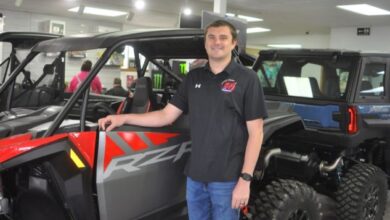PWC – RACING CLOSE-UP, PART TWO
Editors Note: This is the second in a two-part series focusing on the current state of personal watercraft racing in the United States. Last issue, we focused on several of the many challenges facing the sport. This issue, we look at some of the solutions in the works, and the reasons for continued optimism.
Personal watercraft racing. At one time, it appeared ready to lead the wave of extreme sports into the future. Budweiser was a title sponsor of a summer-long tour, outside sponsors were beginning to jump on the bandwagon, and the future looked bright indeed. Somewhere along the way, however, the sport stumbled. Last issue, we examined many of the obstacles that knocked PWC racing off its once-high perch. Now it’s time to see what can be done about it, and where the sport can go in today’s motorsports world. Troubled waters? Maybe not.
The Kids Are All Right
If there’s one nearly universal reason for optimism shared by promoters, racers, and the aftermarket, it’s the potential being witnessed in the youth classes. For arguably the first time in years, young enthusiasts — typically sucked away by sports like motocross and wakeboarding — seem genuinely interested in racing personal watercraft. It’s a trend that many hope is the beginning of a new era in racing.
“Before this year, I really didn’t hear about any young riders who wanted to race,” says Joe Heim, Kawasaki Race Team Manager. “But over in Europe, they’re starting the kids racing really young. The IJSBA just really started pushing the Juniors class this year and it seems really good. I think some of the things happening right now will definitely help the sport.”
“I truly believe that youth racing and rebuilding our sport with energized blood will make the greatest impact,” agrees Jacque Bryant, race promoter and the man behind the creation of the racer-driven United States Watercross Riders Association. “At the World Finals this year, I felt as though the talent that was there with the 14-15 year olds was incredible. I know from talking with (IJSBA racing head) Yves Van Heers that the kids they have over in Europe that are 10-11 years old are pretty phenomenal. My hope is that the insurance companies will recognize we’ve gone two years and not had any significant accidents, will allow us to bring that age limit down even lower, to maybe 12 years old.”
In fact, the American PowerBoat Association has already done just that in the Ski ranks, lowering the official competition age to 12. It’s a change that APBA’s Patrick Mell admits could work wonders for the sport in the long term, as racers will be able to grow with the sport, rather than be swayed by other forms of motorized racing that might have otherwise stolen their interest early on. “The Juniors class is definitely growing,” explains Mell. “Promoters are starting to see a lot of people. If we get these kids young they’ll stay with the sport.”
The catch, naturally, is the issue we mentioned in part one of this report: Most waterways require that riders be at least 16 years old before they’re allowed to operate PWC alone. Whether the younger racers are simply ignoring the rule or practicing in private waterways remains to be seen.
Stand On Your Feet…Or Take A Seat
With the renewed interest from youthful competitors has also come a renewed interest in an old class — stand-up. Most industry insiders we spoke with agree that the Ski classes have the most potential for the future, and as such, should be paid close attention to as racing undergoes a potential rebound.
“From a promoter standpoint, we were blessed in region six to see a huge resurgence in the Novice and Pro-Am Ski Stock,” says Bryant. “We were averaging close to 16 novices a race, and somewhere close to 22-24 Pro-Am Ski stand-ups.”
The reasons for the change are many. For starters, the stock ski class is a cheap way to get into racing. “Money doesn’t necessarily dictate who wins the race,” Bryant continued. “It’s the guy that’s got the talent, the ability to put himself in the position to claim the overall.”
Kawasaki’s Heim agrees that the stand-up class is definitely more cost-effective. He also, however, finds the class easier to identify with from the racer’s perspective. “I think the stand-up class is going to be really key to rebuilding this sport again,” he says. “The really hardcore racers and enthusiasts can relate to the stand-up more than a runabout.”
That doesn’t mean runabout racing will go away. In fact, several people we spoke with find it has great potential, albeit in a slightly different format. The Supercourse style of competition seems to have drawn the most favor recently, with promoters looking to open up the course to display the runabout’s horsepower potential. The APBA in particular is looking at ways to bring runabout racing into existing powerboat races, where the sport will be guaranteed a large and enthusiastic audience. Courses will be based on the powerboat race’s existing ovals, but with additional buoys worked into the inside and outside of the circle to boost excitement and showcase a PWC’s unique maneuverability.
“This will expose the sport to a whole lot of spectators,” explains Mell. “Many of these events get over 100,000 people. That’s probably more than all of our events had last year in total, including the World Finals.”
More Possibility
While spectator attendance is an obvious advantage to riding on powerboat racing’s coattails, there’s also the issue of money. These very same events Mell is targeting also feature paid attendance. That means money for a purse that may help attract the country’s best racers. Many also are already televised, guaranteeing additional exposure. “A lot of these events we’ve had so far, the crowd really likes it,” said Mell, “People can relate to it, they’re enthused about it.”
Offshore racing is yet another possibility. “I think that could open it up a lot,” continues Mell. “If we can get these offshore races to include a personal watercraft class, there’s a lot of people who like going fast, but they don’t want to go race closed course.”
Defining Moment
The biggest hopes, however, continue to center around some sort of “defining moment”
for the sport, an opportunity to strut its stuff
in the X Games or Gravity Games, or break through in some other form of television-friendly, extreme event.
“Hooking up with one of those events could help put it on the map,” said Mell. “And maybe we’d have to just do freestyle. But we have to create something new. They do have snocross, but most of this other stuff, they’re not interested. If they want personal watercraft, they want the 10 top guys and they want jumps in the water and they want a 5-minute race. That’s their format.
“We’ve just got to have to be able to deliver that.”




